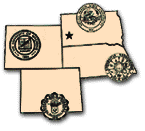Animal Science, Department of

Range Beef Cow Symposium
Date of this Version
December 1991
Document Type
Article
Abstract
Crossbreeding advantages and disadvantages and crossbreeding systems are not new subjects in the United States beef industry. Crossbreeding has been in practice throughout my lifetime. It would be very difficult to locate a straight bred commercial cow herd in the midwest. Nevertheless, there are still misinterpretations and mistakes being made with crossbreeding methods.
It would be sage to say that a vast majority of producers made their first cross to gain breed complementarity. Straight bred cow herds were bred to a bull of a different breed, usually new breed, to gain the inherent trait advantage of that breed. This was also done to start an "up grading" program of that breed. This is not necessarily a mistake. However, full credit for advantages of the resulting F1 over straight breds, was normally given to the sire breed. Little credit, if any, was given to heterosis or the dam breed. This leads us to the common statement about several breeds introduced into the United States during the last quarter century. "The one half bloods are preferred but the three quarter bloods and higher are not as desirable." This could be true because of breed characteristics, too much of a good thing such as too big, or too lean, or because heterosis was decreasing as we moved toward purebred status, lower reproduction, less calf survival.
The two advantages of crossbreeding are heterosis and breed complementarity. If either is taken to extreme or ignored completely then mistakes can result. For example, we as breeders have been guilty of breeding cattle by pieces. With the use of crossbreeding and the ever increasing choice of breeds this possible mistake can be accomplished to greater extremes. A typical scenario would be the historical development of Cowboy Tom's Herd. Tom's extension agent told him years ago that his weaning weights were too low and his herd was in need of more milk. Cowboy Tom used a dairy breed to add milk. Tom then realized at the county fair that his calves were too small, so Tom added a large continental breed. A year later Tom's vet recommended a small breed for calving ease, and the sale barn owners suggested a heavy muscle breed for carcass merit, and the packer-buyer, later on, recommended yet another breed for marbling. As you can guess by now, Tom's herd today represents a typical industry problem of extreme variation. There is too much range in: carcass weight, fat cover, marbling, cow size, birth weights, fleshing ability, and on and on. This mongrelization is not the fault of crossbreeding even though it has often been blamed. It is the fault of single trait selection without a long term, sound, breeding program. Cattle should not be bred by impulse, by extremes, or in pieces, but as complete, optimal wholes, one generation after another. Cattle should be bred making moderate directional changes based on management ease and net profit without giving up the whole.


Comments
Published for Proceedings, The Range Beef Cow Symposium XII December 3, 4 & 5, 1991, Fort Collins, Colorado.